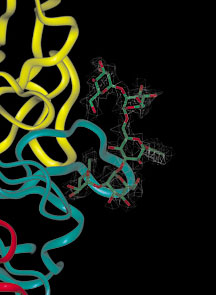Antigen Synthesis—A Step Forward Towards an AIDS Vaccine
By Jason Socrates Bardi
The outlook for acquired immunodeficiency syndrome (AIDS)
worldwide is bleak.
The World Health Organization estimates that around 40 million
people worldwide are already living with the human immunodeficiency
virus (HIV), which causes AIDS. During 2001 alone, more than
four million men, women, and children succumbed to the disease,
and by the end of that year, the disease had made orphans
of 14 million children. In the United States, 40,000 people
are infected with HIV each year.
One of our best hopes to stem this rising tide of infection
is to develop a vaccine against HIV. Vaccines have done wonders
to control diseases like measles and polio in much of the
world, and in the 1970s, vaccines were instrumental in eradicating
smallpox. Almost since the first days of HIV research in the
1980s, government agencies, foundations, and private companies
have supported efforts to develop vaccines to protect against
HIV—so far without success.
Now a team of scientists at The Scripps Research Institute
has taken a step forward on this long road. In a recent issue
of the scientific journal Angewandte Chemie, the team
has defined details of the action of an antibody that broadly
neutralizes HIV. Last year Scripps Research Immunology Professor
Dennis Burton and Molecular Biology Professor Ian Wilson described
the structure of the antibody, which is called 2G12.
The 2G12 antibody recognizes a dense cluster of mannose
sugars on one region of the surface glycoprotein of HIV. This
region is conserved (invariant) in many strains of HIV, which
is why the antibody is able to broadly neutralize the virus.
Approximately half of the world's viruses are neutralized
by the antibody. It was originally identified from an HIV-positive
individual about a decade ago by Hermann Katinger, a doctor
at the Institute for Applied Microbiology of the University
of Agriculture in Vienna, Austria.
In the current study, Burton and Wilson teamed up with Scripps
Research Chemistry Professor Chi-Huey Wong to design and test
synthetic constructs that would mimic the cluster of sugars
recognized by 2G12 and would constitute a potential vaccine
lead.
Using a technique Wong invented called programmable one-pot
synthesis, the Scripps Research team designed several novel
mannose compounds that bind to 2G12. The one-pot technique
allows Wong to quickly assemble many types of carbohydrate
structures by placing a large number of specific chemical
building blocks into a reaction vessel and then making sequential
chemical reactions in the soup.
Burton says that the synthesis of these antigen-like compounds
is the first stage of an approach that he likes to call "retrovaccinology,"
which works backward from the antibody to the vaccine. The
hope is that the information reaped from the study of how
these synthetic compounds bind to the 2G12 antibody could
eventually be used to make a prophylactic vaccine to protect
people against HIV infection.
To read the article, "Reactivity-Based One-Pot Synthesis
of Oligomannoses: Defining Antigens Recognized by 2G12, a
Broadly Neutralizing anti-HIV-1 Antibody" by Hing-Ken Lee,
Christopher N. Scanlan, Cheng-Yuan Huang, Aileen Y. Chang,
Daniel A. Calarese, Raymond A. Dwek, Pauline M. Rudd, Dennis
R. Burton, Ian. A.Wilson, and Chi-HueyWong, please see the
February 13, 2004 issue of Angewandte Chemie (2004,
43, 1000-1003) or go to: http://dx.doi.org/10.1002/anie.200353105.
The research was supported by The Skaggs Institute for Research,
by grants from the National Institute of Allergy and Infectious
Diseases (NIAID) and the National Institute of General Medical
Sciences (NIGMS), by the International AIDS Vaccine Initiative
(IAVI), and by the Pendleton Trust.
Send comments to: jasonb@scripps.edu

|

Computer model of a synthetic antigen
interacting with the 2G12 antibody. Image
by Fu-Sen Liang and Doug Wu.
|

